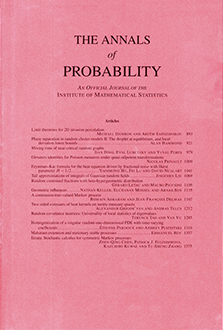Abstract
Consider the inhomogeneous contact process on $Z^1$ with recovery rate $\delta(k)$ at site $k$ and infection rates $\lambda(k)$ and $\rho(k)$ at site $k$ due to the presence of infected neighbors at $k - 1$ and $k + 1$ respectively. A special case of the main result in this paper is the following: Suppose that the environment is chosen in such a way that the $\delta(k)$'s, $\lambda(k)$'s and $\rho(k)$'s are all mutually independent, with the $\delta(k)$'s having a common distribution, and the $\lambda(k)$'s and $\rho(k)$'s having a common distribution. Then the process survives if $E\frac{\delta(\lambda + \rho + \delta)}{\lambda\rho} < 1,$ while the right edge $r_t$ of the process with initial configuration $\cdots$ 111000 $\cdots$ satisfies $\lim\sup_{t\rightarrow\infty}r_t = +\infty$ if $E\log\frac{\delta(\lambda + \rho + \delta)}{\lambda\rho} < 0.$ If the environment is deterministic and periodic with period $p$, we prove survival if $\Pi^p_{k=1}\frac{\delta(k)\lbrack\lambda(k) + \rho(k - 1) + \delta(k)\rbrack}{\lambda(k)\rho(k - 1)} < 1$ and $\Pi^p_{k=1}\frac{\delta(k - 1)\lbrack\lambda(k) + \rho(k - 1) + \delta(k - 1)\rbrack}{\lambda(k)\rho(k - 1)} < 1.$
Citation
Thomas M. Liggett. "The Survival of One-Dimensional Contact Processes in Random Environments." Ann. Probab. 20 (2) 696 - 723, April, 1992. https://doi.org/10.1214/aop/1176989801
Information





